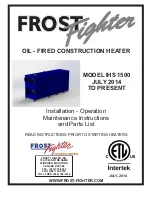
16
17
OPERATING INSTRUCTIONS
To check for a leak:
1. Make 2-3 oz. leak check solution (one part
liquid dishwashing detergent and three parts
water).
2. Apply several drops of solution where
regulator connects to cylinder and to all hose
and valve connections
3. Make sure all patio heater and light valves
are OFF.
4. Turn cylinder valve ON.
If bubbles appear at any connection, there is a
leak.
1. Turn cylinder valve OFF.
2. If leak is at regulator/cylinder valve connection:
Disconnect, reconnect, and perform another
leak check. Apply the soapy solution to all hose and
valve connections. If you continue to see bubbles
after several attempts, cylinder valve is defective
and should be returned to cylinder’s place of
purchase.
3. If leak is at hose/regulator connection:
This part is defective and you should contact the
customer service department for replacement.
If NO bubbles appear at any connection, the connections are secure.
NOTE: Whenever gas connections are loosened or removed, you must perform a complete leak test.
1
!
Perform all leak tests outdoors.
• Extinguish all open flames.
• NEVER leak test when smoking.
• Do not use the heater until all connections
have been leak tested and do not leak.
WARNING
Regulator / Cylinder
connection
ASSEMBLY INSTRUCTIONS
15. Connect gas hose and regulator (P) to control
box assembly (I). Do not cross-thread.
WARNING:
Ensure gas hose does not contact any
high temperature surfaces, or it may melt and leak
causing a fire.
16. Screw gas hose and regulator (P) to propane
cylinder (not included). Do not cross-thread.
WARNING: Use a standard 20 lb. propane cylinder
only.
Use this heater only with a propane vapor
withdrawal supply system. See chapter 5 of the
standard for storage and handling of liquefied
petroleum gas, ANS/NFPA 58. Your local library or
fire department should have this book.
A minimum supply pressure of 0.4 P.S.I. is required
for the purpose of input adjustment for propane
gas. Storage of an appliance indoors is permissible
only if the cylinder is disconnected and removed
from the appliance. A cylinder must be stored
outdoors in a well-ventilated area out of the reach
of children. A disconnected cylinder must have dust
caps tightly installed and must not be stored in a
building, garage or any other enclosed area. The
minimum permissible gas supply pressure of 10
W.C. is required for purpose of input adjustment. A
minimum of 17,000 BTUs per hour is the required
input rating for a heater with a rating less than full.
The pressure regulator and hose assembly
supplied with the appliance must be used.
The installation must conform with local codes,
or in the absence of local codes,with national fuel
gas code, ANS Z223.1/NFPA54, natural gas and
propane Installation Code, CSA B149.1, or propane
storage and handling code, B149.2.
15
16
P
P
I































